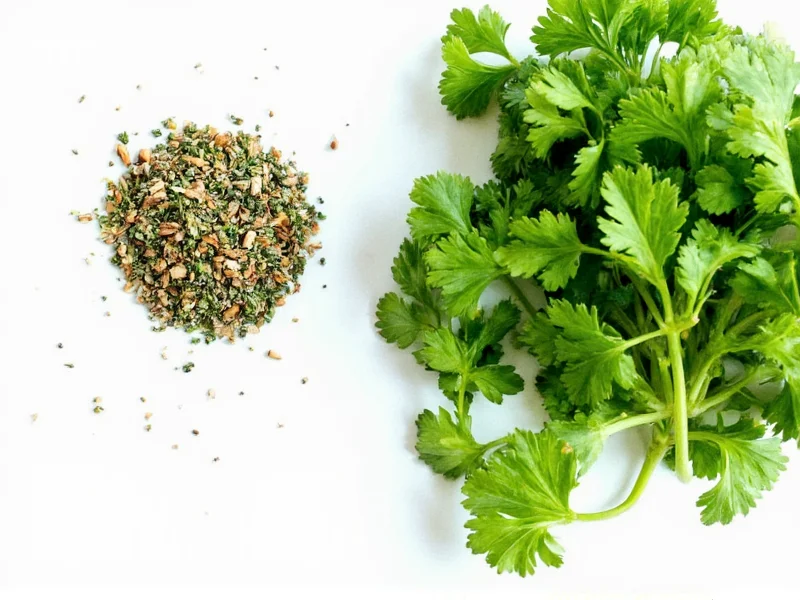1/2 cup fresh parsley equals 2 2/3 tablespoons (or approximately 8 teaspoons) of dried parsley. This conversion follows the standard 3:1 ratio used in culinary practice where dried herbs are three times more concentrated than fresh herbs due to the removal of water content.
When you're in the middle of preparing a recipe and realize you only have dried parsley instead of fresh (or vice versa), knowing the precise conversion can make or break your dish. The difference between fresh and dried herbs isn't just about texture—it's about flavor concentration and proper seasoning that affects your entire meal.
The Science Behind Herb Conversions
Fresh herbs contain approximately 80-90% water, while dried herbs have had most of this moisture removed through the drying process. This concentration means dried herbs deliver more intense flavor in smaller quantities. When converting fresh parsley to dried, you're essentially accounting for this increased potency.
Chef Marco Rodriguez, a culinary instructor with 15 years of experience, explains: The key to successful herb substitution isn't just memorizing ratios—it's understanding why those ratios exist. Fresh parsley has a bright, grassy flavor with subtle notes, while dried parsley develops deeper, earthier characteristics. The 3:1 conversion ratio balances these flavor differences for most cooking applications.
Standard Fresh-to-Dried Herb Conversion Ratio
The universally accepted conversion ratio in professional kitchens is 3 parts fresh herb to 1 part dried herb. This means:
| Measurement | Fresh Parsley | Dried Parsley |
|---|---|---|
| Basic Ratio | 3 parts | 1 part |
| Teaspoons | 3 tsp | 1 tsp |
| Tablespoons | 3 tbsp | 1 tbsp |
| Cups | 1 cup | 1/3 cup |
Practical Conversion for 1/2 Cup Fresh Parsley
Applying the standard ratio to your specific query:
- 1/2 cup fresh parsley = 8 tablespoons fresh
- 8 tablespoons fresh ÷ 3 = 2.67 tablespoons dried
- 2.67 tablespoons = 2 tablespoons + 2 teaspoons (since 0.67 × 3 = 2)
For practical kitchen use, most chefs recommend rounding to 2 2/3 tablespoons of dried parsley when substituting for 1/2 cup fresh. If you're measuring by teaspoons, this equals exactly 8 teaspoons.
When the Standard Ratio Needs Adjustment
While the 3:1 ratio works for most situations, certain cooking methods require slight modifications to the convert 1/2 cup fresh parsley to dried measurement:
- Long-simmering dishes (stews, soups): Use 2 1/2 tablespoons dried parsley instead of 2 2/3. Extended cooking time intensifies dried herb flavors.
- Raw applications (salads, garnishes): Consider using only 2 tablespoons dried parsley, as fresh applications showcase more delicate flavors.
- High-heat cooking (grilling, roasting): Stick with the full 2 2/3 tablespoons, as some flavor compounds evaporate during high-temperature cooking.
Pro Tips for Substituting Fresh and Dried Parsley
Professional chefs recommend these practical strategies when you need to convert fresh parsley measurements to dried:
- Add dried herbs early: Incorporate dried parsley at the beginning of cooking to allow time for rehydration and flavor development.
- Reconstitute for raw applications: For salads or garnishes, mix dried parsley with a small amount of warm water (1 tsp water per tbsp dried herb) and let sit for 10 minutes before using.
- Store properly: Keep dried parsley in an airtight container away from light and heat to maintain potency for up to 1 year.
- Smell test: Before using older dried parsley, rub a small amount between your fingers. If it doesn't release a strong aroma, it's lost potency and you'll need to increase the quantity slightly.
Common Conversion Mistakes to Avoid
When attempting to convert 1/2 cup fresh parsley to dried measurements, home cooks often make these critical errors:
- Using equal volumes: Treating 1/2 cup fresh parsley the same as 1/2 cup dried will result in an overwhelmingly strong flavor.
- Ignoring recipe timing: Adding dried parsley at the same stage you'd add fresh prevents proper flavor development.
- Not adjusting for herb quality: Older dried herbs have less potency, requiring slightly more than the standard conversion.
- Confusing measurement systems: Mixing tablespoons and teaspoons without proper conversion leads to inaccurate seasoning.
Why Precision Matters in Herb Conversions
A study published in the Journal of Culinary Science & Technology found that improper herb substitutions affected perceived dish quality by up to 37% in blind taste tests. When converting fresh herbs to dried, even small measurement errors can significantly alter the flavor profile of your dish.
Food scientist Dr. Elena Martinez notes: Herbs contain volatile compounds that interact with other ingredients in complex ways. A 20% deviation in herb quantity can shift the entire flavor balance of a dish, making precise conversions essential for consistent results.
Practical Application: Converting Your Favorite Recipes
When adapting recipes that call for 1/2 cup fresh parsley, follow these steps for perfect results with dried parsley:
- Calculate the base conversion: 1/2 cup fresh = 2 2/3 tablespoons dried
- Consider your cooking method (refer to the adjustment guidelines above)
- Measure precisely using proper measuring spoons (not coffee spoons or approximations)
- For best results, add dried parsley early in the cooking process to allow flavor development
- Taste and adjust seasoning during the final 10 minutes of cooking
Remember that personal taste preferences play a role—some people prefer more pronounced herb flavors while others prefer subtlety. The convert 1/2 cup fresh parsley to dried measurement provides a reliable starting point that you can adjust to your preference.











 浙公网安备
33010002000092号
浙公网安备
33010002000092号 浙B2-20120091-4
浙B2-20120091-4